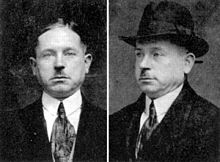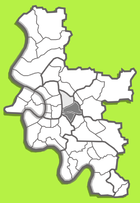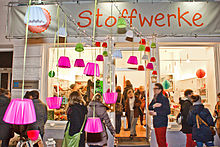Flingers
|
Flingern district of the state capital Düsseldorf |
|||
|---|---|---|---|
|
|
|||
| Basic data | |||
| Geographic location : | 51 ° 14 ′ N , 6 ° 49 ′ E | ||
| Height: | 44 m above sea level | ||
| Surface: | 4.28 km² | ||
| Residents: | 34,199 (December 31, 2016) | ||
| Population density : | 7,990 inhabitants per km² | ||
| District: | District 2 | ||
| Transport links | |||
| Bundesstrasse : |
|
||
| S-Bahn : | S 1 S 6 S 8 S 11 P 28 P 68 | ||
| Light rail : | U 71 U 72 U 73 U 75 U 83 | ||
| Tram : | 706 708 709 | ||
| Bus route: | 725 734 736 737 738 834 | ||
| Night traffic: | NE 2 NE 3 NE 4 NE 5 810 815 | ||
Flingern is a traditional workers' residential area east of downtown Düsseldorf in Düsseldorf's district 2 .
Flingern is made up of the districts of Flingern North with currently 23,851 inhabitants and Flingern South with currently 10,348 inhabitants, which together extend over an area of 4.28 km² (all as of December 31, 2016). Both parts of the city have developed differently since industrialization. From the 1980s onwards, this difference deepened. Today, Flingern Nord, with its old building stock, is a predominantly younger urban district that is subject to an increasing gentrification process. Flingern Süd, on the other hand, has retained its industrial character and is still a working-class district with a high proportion of migrants.
Despite these differences, the two parts of the city are perceived as one in practice. Even the urban traffic signs only indicate “Flingern”.
geography
Flingern is located south of Düsseltal , northeast of Oberbilk , north of Lierenfeld , southwest of Grafenberg and east of the city center . The Düsseldorf – Wuppertal railway line separates the districts of Flingern North and Flingern South.
Demographics
Flingern North
In Flingern Nord, 21,056 people (as of November 30, 2007) live in around 12,000 households. Most of the residents (over 9,000) belong to the 18 to 49 age group. The average age is 42 years. Young people make up 8.9% of the total population. All types of schools with the exception of comprehensive schools are located in the district. At 18.9%, the proportion of non-German citizens is slightly above the urban average, while the unemployment rate at 19.1% is well above the average.
Flingern south
In Flingern Süd there are slightly fewer people, namely 9,522 people (as of November 30, 2007) in around 5,200 households. The population density is slightly lower than in the north. Most of the residents in Flingern Süd also belong to the 18 to 49 age group, the relative share is slightly higher (47%) than in the north of Flingern, the relative share of young people is also higher (10%). The average age is only 39 years, i.e. 3 years below the urban average. At 34.2%, the proportion of non-German citizens is well above the average, the unemployment rate at 26.6% is well above the average for the city and the rate in northern Flingern, which is already above the urban mean.
history

In 1193 Flingern was first mentioned together with Lintorf, Saarn, Stockum, Ratingen and Derendorf. This area was largely covered with forest and the "forest county" was assigned to the Kaiserswerth monastery by Emperor Heinrich VI. confirmed in a certificate. The northeastern area between Düsseldorf and Gerresheim was only sparsely populated. The area was ruled no later than the second half of the 13th century by the knight family Hayc von Flingern, who served as timber and margraves. In the 13th and 14th centuries, the city of Düsseldorf grew largely on the grounds of the Flinger Knights, some of whose possessions were also located in today's old town. They had their farm on Mühlenplatz. The family of the Knights of Flingern lost their importance as early as the 14th century. The Speckerhöfen, which was originally located in the Flingerwald, became the Düsselthal monastery and the surrounding district of Düsseltal , which is popularly known as the Zooviertel and connects to Flingern to the north.
Elector Jan Wellem built Flinger Steinweg (today's Schadowstraße in downtown Düsseldorf) by paving the way from Düsseldorf's core city to Flingern. An important connecting road to the Gerresheimer Heights was the Hellweg leading through Flingern even in earlier times.
Flingern developed into a workers' residential area during industrialization. The industrial structure is still clearly visible in Flingern Süd today. The district is characterized by the waste incineration plant and the Flingern thermal power station with the headquarters of the Düsseldorfer Stadtwerke and a municipal recycling yard as well as medium-sized businesses, a hardware store and a scrapyard. The new water park at the location of the old one on Kettwiger Straße (outer facade of the previous building from the early 1930s), the new " Automeile " and the redesign of the municipal utility center also show the beginning change, such as the municipal utility park that opened in 2005 . Allotment gardens in Flingern, which is poor in green spaces, also provide compensation.
Flingern Süd was the home and place of work of the serial killer Peter Kürten , who lived at Mettmanner Straße 71 in the 1920s and early 1930s. The Paul Janes Stadium at the “Flinger Broich”, the venue for soccer legends like Toni Turek , Jupp Derwall , Klaus Allofs and Paul Janes , is the nucleus of the Fortuna Düsseldorf soccer club .
present


Due to a series of technical experiments in 1980, the place was named after the Flingern corrosion diagram .
In contrast to the southern part, Flingern Nord has become a cultural and shopping district. As a shopping street, Birkenstraße covers everyday needs, while the area around Ackerstraße and Hermannplatz has attracted the gastronomy scene, young designer fashion shops and art galleries. The events Flingern at night and Kunstpunkte (opening of artist studios to the public) attract particular attention . The galleries and exhibition halls of the district, including the collection Philara in the Birch Street 47a, the Galerie Konrad Fischer in Platanenstraße 7 and the gallery plan.d. in Dorotheenstrasse 59, established themselves as a sought-after location for the international art trade. In connection with the structural change and the increased attractiveness, the district, which was considered run down 20 years ago, is being supplemented with high-quality residential construction. The building and modernization boom that characterizes Flingern's current development is expected to bring several thousand new residents to the district in the coming years. This boom also leads to displacement effects.
Well known is Zakk , located in Fichtenstrasse in Flingern Süd , the center for contemporary art, characterized by alternative urban culture. The events range from disco, dance evenings and live performances by popular bands to more or less well-known small actors. It's in the immediate vicinity of Kiefernstrasse , which gained nationwide attention during the heyday of the squatting in the 1980s . In the 1980s and 1990s, the current music and disco scene, especially the techno scene (1990s), found a home in the form of the large discotheques Stahlwerk and Tor 3 on Ronsdorfer Strasse in Lierenfeld , which is part of the 8th district . Until the end of 2008, the "Café Rosa Mond", an autonomous lesbian and gay center, was located here in the former premises of the "Lesbian and Gay Center Düsseldorf (LuSZD)". The musical house Capitol and the neighboring Tanzhaus NRW both found their premises in converted halls and houses of an abandoned tram depot on the eastern edge of the district not far from the main train station .
In an explosives attack on July 27, 2000, a pipe bomb filled with TNT exploded at the Ackerstrasse entrance to the Wehrhahn S-Bahn station . Ten people were injured, some of them life-threateningly, and a woman who was five months pregnant lost her unborn child.
traffic
Flingern is connected to the Rhine-Ruhr S-Bahn through the Düsseldorf-Flingern and Düsseldorf-Wehrhahn S-Bahn stations . At Flingern station the lines S 8 run to Mönchengladbach , Wuppertal and Hagen , from Hagen as S 5 also to Dortmund , S 28 to Kaarst and Mettmann and at times the S 68 to Wuppertal-Vohwinkel and Langenfeld (Rhineland) . At Wehrhahn station, the S 1 lines run to Solingen and in the direction of the Ruhr area via Duisburg , Essen , Bochum to Dortmund, S 6 to Cologne and Essen, S 11 to Düsseldorf Airport and Bergisch Gladbach via Cologne. All lines run through Düsseldorf Central Station . The main train station can be reached very quickly from Flingern Süd.
The tram lines U 71, U 72, U 73, U 75 and U 83 as well as the tram lines 706, 708 and 709 connect Flingern with the city center, Oberkassel, Düsseltal, Grafenberg, Eller, Bilk and other parts of the city as well as Neuss and Ratingen.
The federal road 8 leads through Flingern.
Personalities
- Kurt Borkenhagen (1919–2012), national soccer player
literature
- Bärbel Hanenberg-Kranz: FLINGERN Kiez, Art & Culture , Droste Verlag 2011, ISBN 9783770014385
Individual evidence
- ↑ https://www.duesseldorf.de/fileadmin/Amt12/statistik/stadtforschung/download/stadtteile/Flingern_Nord_022.pdf Statistics of the state capital Düsseldorf on the district Flingern Nord
- ↑ https://www.duesseldorf.de/fileadmin/Amt12/statistik/stadtforschung/download/stadtteile/Flingern_Sued_021.pdf Statistics of the state capital Düsseldorf on the district Flingern Süd
- ↑ Martin Teigeler: Gentrification in Big Cities: From the Malocher Quarter to the Top Location . Article from July 24, 2013 in the portal www1.wdr.de , accessed on August 10, 2013
- ↑ OpenStreetMap / Relation / Flingern Nord (91146) . Retrieved August 6, 2009.
- ↑ OpenStreetMap / Relation / Flingern Süd (91145) . Retrieved August 6, 2009.
- ^ Theodor Joseph Lacomblet, in: Document book for the history of the Lower Rhine and the Archbishopric of Cöln, Certificate 540 , 1840, Part 1, p. [393] 377. Online edition 2009 [1]
- ^ State capital Düsseldorf - Düsseldorfer Stadtchronik 1930
- ↑ The Vampire of Düsseldorf. The Kürten files. The file (18): Maria Budlies (May 14, 1931) , website March 9, 2011, accessed August 7, 2013
- ↑ kaufen-duesseldorf-flingern.de , website
- ↑ http://www.einkaufen-duesseldorf-flingern.de/flingern-night
- ^ Duesseldorf.de : Cultural Office of the State Capital Düsseldorf
- ↑ Holger Lodahl: Art scene in Flingern celebrates a super year ( Memento of the original from December 20, 2014 in the Internet Archive ) Info: The archive link was automatically inserted and not yet checked. Please check the original and archive link according to the instructions and then remove this notice. . Article from December 20, 2014 in the portal rp-online.de , accessed on December 20, 2014
- ↑ rp-online.de: How the change will continue in Flingern , November 28, 2013
- ↑ Semiha Ünlü: “Trinkhalle” celebrates a farewell party on January 2nd . Article from December 20, 2014 in the portal rp-online.de , accessed on December 21, 2014
Web links
- Historical representation on the website of the city of Düsseldorf : Where the Knights of Flingern once ruled
- Office for Statistics and Elections of the State Capital Düsseldorf : Statistics for the district 021 - Flingern Süd
- Office for Statistics and Elections of the State Capital Düsseldorf : Statistics for the district 022 - Flingern North
- Information from the city of Düsseldorf about Flingern Nord
- Information from the city of Düsseldorf about Flingern Süd


